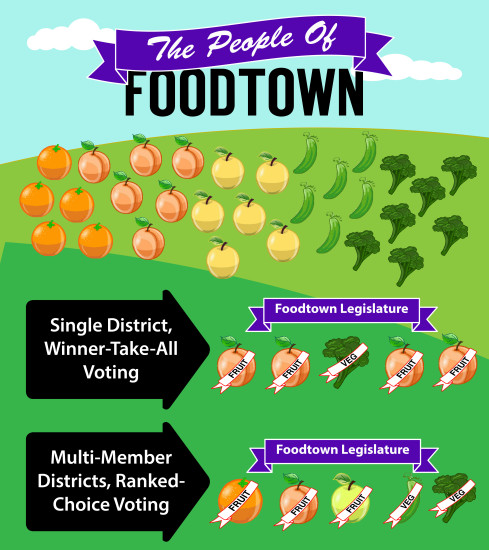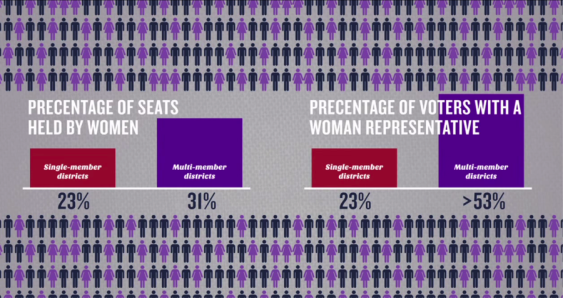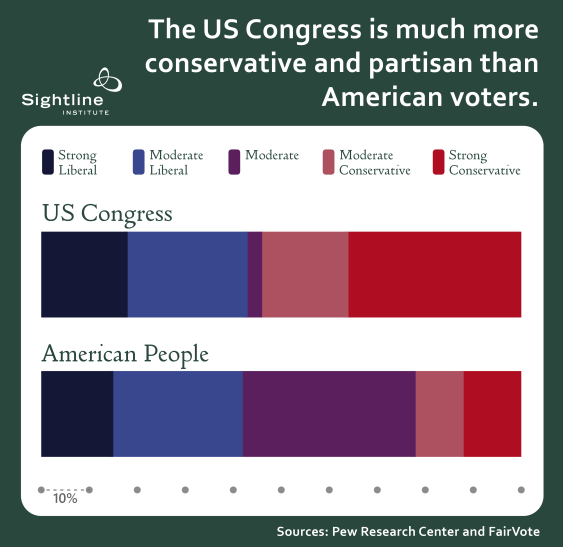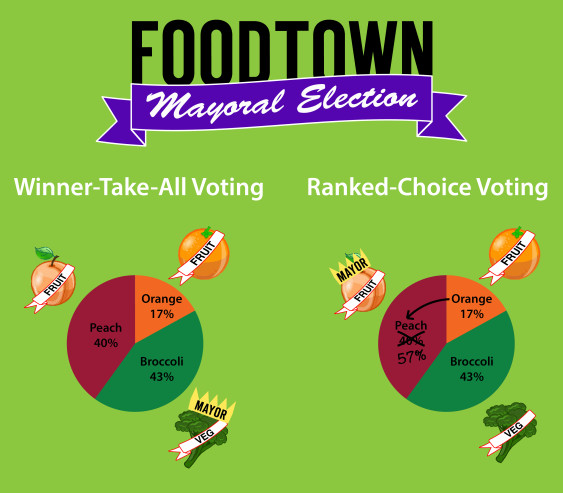If you put your money in a vending machine and punched in the number for trail mix, but it instead gave you a pack of gum, would you use that vending machine again? Unfortunately, voting in North America is often not so different from this vending machine. In the United States, most voters vote Democrat, yet the Republicans control Congress. Voters ask for trail mix but keep getting gum. In Canada, about 35,000 Conservative voters can elect a Conservative Member of Parliament (MP) to represent them, but it takes more than ten times as many—over half a million—Green voters to elect a single Green MP.
This is not how it’s supposed to work. Second US President John Adams believed the legislature “should be in miniature, an exact portrait of the people at large. It should think, feel, reason, and act like them. … [E]qual interest among the people should have equal interest in it.” In other words, the legislature should proportionally represent the people.
[prettyquote align=right]”Winner-take-all elections give the biggest block of voters 100 percent of the representation, and all the other voters get none.”[/prettyquote]
Here’s what an “exact portrait,” proportional representation, would look like: imagine people of different ideological stripes are different fruits and vegetables on a spectrum from orange to green. In Foodtown, 17 percent of voters are oranges, 20 percent peaches, 20 percent apples, 20 percent cucumbers, and 23 percent broccoli. If Foodtown elects a five-member legislature that is “an exact portrait of the people,” it would be one orange, one peach, one apple, one cucumber, and one broccoli.
Unfortunately, in Canada and the United States, winner-take-all elections give the biggest block of voters 100 percent of the representation, and all the other voters get none. In winner-take-all, also known as “first-past-the-post” or “plurality” voting, the candidate with the most votes wins, regardless of how many votes he or she gets. In an election with only two candidates, the winner will need a majority—half plus one—of the votes to win. With three candidates, the winner only needs a plurality of votes to win: one-third of the votes plus one; with four candidates, one-fourth of the votes plus one; etc.
If Foodtown was split into five single-member districts with winner-take-all voting, the biggest voting blocks would win all the seats, so Foodtown might elect five broccolis. Or, likely, Foodtown would get four peaches and one broccoli. In Oregon, 55 percent of voters are Democrats, yet Democrats hold 4 out of 5 Congressional House seats. In 2012, Americans voted for Democratic candidates by a 52-48 margin, yet gerrymandered single-member districts resulted in Republicans winning 57 percent of the House seats.
 Winner-take-all voting and single-member districts make the US Congress much whiter, wealthier, more male, and more partisan than the rest of us. Women, racial and ethnic minorities, and political viewpoints outside the two major parties are all under-represented.
Winner-take-all voting and single-member districts make the US Congress much whiter, wealthier, more male, and more partisan than the rest of us. Women, racial and ethnic minorities, and political viewpoints outside the two major parties are all under-represented.
But there is nothing inevitable about this dearth of representation. We could elect legislatures that accurately represent the people with a simple shift: changing from single-member districts and winner-take-all voting to multi-member districts with ranked-choice voting, or, in Canada, mixed-member proportional representation. With ranked-choice voting, also known as single transferable vote, voters rank multiple candidates in order of preference. With mixed-member proportional voting, voters pick both their favorite candidate and their favorite party. Parties fill legislative seats from a party list to ensure that the each party’s representation in the legislature reflects voters’ party preferences.
Problem: Legislatures aren’t representative of voters.
The US Constitution leaves it up to the states to choose how to elect their representatives. For decades, many members of Congress and most state legislatures used multi-member districts, but over time many switched to single-member districts with “first-past-the-post” or “plurality” voting; whoever gets the most votes wins, even if they don’t get a majority of the votes. Under plurality voting, a candidate with as little as 34 percent of the votes becomes the only representative for 100 percent of the people in that district; sixty-six percent of voters have no representative in office.
[prettyquote align=left]”The legislature should proportionally represent the people.”[/prettyquote]
Imagine Foodtown was split into three districts with the population evenly distributed in each, so peaches, with the support of fellow fruits, oranges and apples, win every seat. Cucumbers and broccolis—a sizable 43 percent of the population—would be completely shut out of their democracy. Or, as this jungle-themed video explains, if you use single-member districts and winner-take-all voting, your legislature will be full of monkeys.
Our winner-take-all elections result in a grossly distorted miniature.
Solution: Proportional representation gives each group of voters a voice proportional to its size.
With multi-member districts and ranked-choice voting, Foodtown would elect one representative of each group, resulting in a legislature that perfectly represents the voters. The United States and Canada would elect more Independents, Liberals, and Greens, more women, and more people of color, reflecting our diverse population. Legislatures would “think, feel, reason, and act” more like voters.
Problem: Women make up half the population, but only a minority of elected officials.
The United States ranks 94th and Canada 60th in the world for female representation because less than 20 percent of Congressional seats and only a quarter of parliamentary seats are held by women. Of Oregon’s seven Congressional members, only one is a woman. Washington is doing better with five out of 12. Oregon and Washington state legislatures and British Columbia’s legislative assembly are above the national averages for female representation, with 31, 33 , and 36 percent, respectively. Despite the dubious distinction of being better than other North American states and provinces, the Cascadian states still don’t have fair gender representation.
Solution: Give women a voice with proportional representation.
In the 1950s, 40 states used multi-member districts in at least one state legislative chamber, but now only ten states do. Of these ten, only six—Arizona, New Hampshire, New Jersey, North Dakota, Vermont, and West Virginia—use complete “bloc” voting in which all candidates run in a single pool, voters get as many votes as there are seats, and two or more top vote-getters win seats. Most states have two seats per district, but the Vermont Senate has some districts with six seats, and the New Hampshire House has as many as 11. Two states, Idaho and Washington, use “seat” or “post” voting in which candidates run for a designated seat, voters cast one vote for each seat, and the single top vote-getter for each seat wins that seat. Scholars argue that designated seat districts like Washington’s should not be classified as multi-member districts because they use winner-take-all voting, just like single-member districts. Two states, Maryland and South Dakota, use a combination of bloc and seat voting.
[prettyquote align=right]”States that switched from single-member to multi-member gained women legislators.”[/prettyquote]
Women candidates fare better in states with multi-member districts, holding an average of 8.2 percent more seats in those states than in exclusively single-member-district states. Six of the 10 states that rank highest for percentage of state legislative seats held by women use multi-member districts: five of them use bloc voting, and one, Washington, uses post voting. States that use both multi-member and single-member districts provide an interesting test case: in 12 of 14 states using both during the 1960s and ’70s, more women won elections in multi-member districts than in single-member ones.
States that switched from multi-member districts to single-member districts lost women legislators. Through 1992, 88 percent of Wyoming’s House of Representatives was elected using multi-member districts—up to five Senate seats per district, and up to nine House seats per district—and Wyoming ranked 11th in the United States for its share of women in the legislature. Then it switched to single-member districts, and its ranking plummeted to 43rd. States that switched from single-member to multi-member gained women legislators. Between 1970 and 1982, Idaho and Montana switched from using both single- and multi-member districts to using only multi-member districts, and both states saw a greater increase in the number of women elected than the average national increase.
From a voter’s standpoint, the difference between single-member and multi-member districts is even more stark: only 23 percent of voters in single-member districts have a woman representing them, but a majority of voters in multi-member districts have at least one woman representative. For example, the Vermont Senate elects 90 percent of its members from multi-member districts with two to six members. Seventy percent of Vermonters have a woman Senator. Neighboring New York uses single-member districts, and only 17 percent of New Yorkers have a woman Senator.

Problem: People of color are under-represented.
Although they have made progress in recent years, people of color are still under-represented at the federal, state, and local levels. Winner-take-all means that the single largest block of voters (usually whites) chooses the only representative for an American district or Canadian riding, and smaller blocks of voters often can’t elect anyone. The United States has a long history of gerrymandering districts—drawing the lines to divide minority communities and dilute their votes to ensure that whites are always the biggest voting block in a district, and minorities have no voice. Not a smaller voice, proportional to their share of the population. No voice.
In the Evergreen State, Latinos are 11 percent of the population, but only hold 2 percent of the seats in the legislature, and there are no Latinos in statewide elected offices. In cities and counties where Latinos constitute a higher percentage of the population, they are even more dramatically underrepresented. Take Yakima: 41 percent of the population is Hispanic, yet a Hispanic candidate has never won a single seat in the City Council. In fact, Graciela Villanueva lost a school board election to Jeni Rice even though Jeni had dropped out of the race.
Solution: Give people of color a proportional voice.
Ever since the 1982 amendments to the Voting Rights Act, cities and states have tried to tackle this failure of representative government by slicing at-large winner-take-all districts into single-member winner-take-all districts and ensuring that the boundaries of one or more of these new districts hold a majority of residents who are members of a racial minority. This is the remedy the US District Court ordered in a recent American Civil Liberty Union (ACLU) case in Yakima: the city must convert its seven at-large winner-take-all districts into seven single-member winner-take-all districts, where two have boundaries drawn to make them Latino-majority districts. This reform will help with Hispanic representation on the city council, but the court really slayed the wrong dragon. The biggest problem isn’t the at-large district; it is the winner-take-all voting.
[prettyquote align=left]”The biggest problem isn’t the at-large district; it is the winner-take-all voting.”[/prettyquote]
In Yakima, there will now be a good chance that two out of seven council members will be Latinos, assuming people in Yakima continue to vote heavily for people of their own ethnicity. But the many Latinos living in the other five districts, and the non-Latinos living in the Latino-majority districts, will not share an ethnicity with their representatives. Shifts in demographics could cause Latinos to lose their slim majority in one or both districts, putting them back where they started.
In contrast, proportional representation would be a fair and durable solution for all Yakima voters, ensuring that no substantive block of voters can be ignored. For example, Yakima could create three at-large seats and let every voter cast a single vote for his or her favorite candidate. The three candidates with the most votes would win a seat, meaning any candidate with support from around one-quarter of the population would win office. Any voter that was part of a group making up about a quarter of the population, such as Latino voters in Yakima, could put his or her favorite candidate in office. This system has worked in Alabama to empower African-American candidates to consistently win at-large seats with support from a block of African-American voters. It also worked in Chicago, electing black candidates as early as 1929.
Problem: Political viewpoints outside the two major parties have almost no representation.
More Americans identify themselves as Independents (39–42 percent) than Democrats (31–32 percent) or Republicans (23–24 percent). Even though they are close to a majority of the population, people outside the two parties have almost no democratic representation. In Oregon, 33 percent of voters are either unaffiliated or registered with a third party, compared to just 30 percent of voters registered Republican and 38 percent Democrat. The Independent Party of Oregon recently attained major party status, but winner-take-all elections have so far prevented the party from electing any state representatives. Washington voters don’t register by party, but as of 2011, a whopping 42 percent said they were Independents, compared to 33 percent Democrats and 24 percent Republicans. Yet, every elected state representative is either a Democrat or a Republican.
Even among party-affiliated voters, many hold a set of views that differs from party lines; they may be socially liberal and fiscally conservative, or strongly religious and pro-government. So why can’t all these Independent, third-party, not-strongly-partisan voters elect a non-major-party candidate? Because in a two-party system perpetuated by winner-take-all voting, voters must choose one of the two parties or throw their vote away.

Solution: Give Independents and other parties a proportional voice.
Multi-member districts with ranked choice voting would enable independents, moderates, and progressives to win seats commensurate with their share of the population. In a three-member district, a block of about 25 percent of voters can elect a candidate; in a five-member district, each block of about 17 percent of voters can elect a candidate.
Problem: Candidates can win executive office with a minority of the votes.
In 11 US presidential elections, a candidate has won with less than 50 percent of the popular vote. Since 2010, some 27 percent of gubernatorial candidates won the election without support from a majority of voters. In each of those elections, the winner had only minority support, and the will of the majority of voters was stymied.
How can this be? In a winner-take-all election, a third-party spoiler can split the vote and, perversely, the candidate with less support will win. See: Bush, Gore, Nader in 2000. In the Foodtown example, imagine Orange, Peach, and Broccoli run for office. Peach and Orange might split the Fruit vote (57 percent of the total), and Broccoli, with support from only 43 percent of voters, would become Mayor. (If you prefer fauna to flora, see this video explaining the winner-take-all problems with jungle animals.)
Solution: Ensure the candidate with the most overall support wins.
[prettyquote align=right]”Ranked choice voting lets you vote for your true first choice candidate without fear that you are inadvertently electing your least favorite candidate.”[/prettyquote]
Ranked-choice voting solves the spoiler problem (aka: vote-splitting). In Foodtown, if voters could rank their choices for Mayor, 17 percent of voters would pick Orange as their first choice, 40 percent Peach, and 43 percent Broccoli. Since no candidate has yet gotten majority support, Orange would be eliminated and those voters’ second-choice votes would be distributed. If they all went to Peach, she would win handily, as one would expect given that most voters are Fruit.
From a voter’s perspective, ranked choice voting lets you vote for your true first choice candidate without fear that you are inadvertently electing your least favorite candidate.

A true democracy requires proportional representation.
John Stuart Mill said: “In a…democracy, every section would be represented…proportionately. A majority of the electors would always have a majority of the representatives; but a minority of the electors would always have a minority of the representatives.” Anything else would be a “needless injustice” “contrary to the principle of democracy,” unfairly allowing “one part of the people rule over the rest.”
In Canada and the United States, we are suffering a needless injustice. Our elections are set up so that one part of the people rules over the rest. Voters are asking for trail mix, but the system keeps giving us gum. We can remedy this defect and achieve justice with fair voting and proportional representation. In my next articles, I’ll lay out additional ways that fair voting makes the whole system work better, how fair voting works in American and Canadian cities, and in countries around the world, and what changes Cascadia would need to do to implement fair voting here.
Thanks to Nick Abraham for help with research on this article, and to Adiel Kaplan for the Foodtown graphics.


Comments are closed.